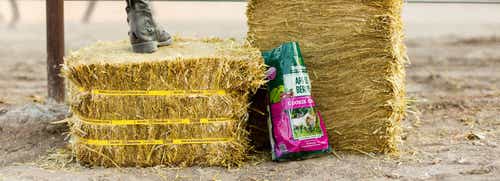
Therapeutic Forage – Horse Health Through Diet
As horse owners, we understand the importance of providing our equine companions with the right nutrition to support their overall well-being. Dr. Stephen Duren, Ph.D. Equine Nutritionist, explains how understanding a horse's nutritional needs through their digestive system can help us make informed choices when it comes to their diet.
We will also discuss the importance of choosing the right forage for horses with EGUS - Equine Gastric Ulcer Syndrome, as well as proper feeding practices for horses with 'sugar' related diseases.
Understanding a Horse's Nutritional Needs through their Digestive System
The digestive system of a horse is uniquely designed for consumption and digestion of forage (pasture/hay). A small, simple stomach designed for small, frequent meals and an expansive cecum and colon containing a diverse microbiome to ferment plant fiber make the horse ideally suited to slow continuous consumption of forage.
The “standard” 1,000-pound horse will consume between 1.5 – 2.5% of body weight in dry forage per day. This equates to 15 – 25 pounds of dry forage per day, or when we account for the small amount of moisture in hay, this means we will be providing 17 – 28 pounds of baled hay per day. The consumption of forage provides the majority of calories, protein, minerals and vitamins to most horses. In addition to the nutrients provided, forage also physically stimulates contraction and normal movement of gas and waste material through the digestive tract. So, the correct intake of high-quality forage will provide a host of nutrients and aid in the proper function of the digestive system, but specific forages can also be therapeutic for horses with certain disease conditions.
Choosing the Right Forage for Equine Gastric Ulcer Syndrome (EGUS)
Horses can develop ulcers in their stomach. These ulcers are caused by stomach acid coming in contact with unprotected regions of the stomach. Since the digestive system of the horse is designed for small frequent meals, they do not have the ability to turn on and turn off acid secretion in the stomach. Acid is buffered or neutralized in the stomach by consumption of forage, which stimulates chewing and the production of saliva, the main stomach acid buffer. Performance horses, or any horse, that receives less forage and proportionally more grain concentrate to fuel high-calorie requirements, has an increased likelihood of developing a stomach ulcer. This is simply because when a horse consumes a grain concentrate, they produce less saliva than when they consume the same amount (weight) of forage.
We have now learned that help can be provided to horses with this medical condition by feeding a specific “type” of forage. Alfalfa forage can assist horses with gastric ulcers in two ways. First, the calcium contained in alfalfa hay is capable of buffering stomach acid. Second, the calories contained in alfalfa help satisfy energy needs, meaning less grain is necessary in the diet.
The amount and timing of the alfalfa feeding is also important. It only takes a small meal (2-3 pounds) of alfalfa to achieve a buffering effect. However, the timing of this meal is critical. The alfalfa meal should be fed approximately 30 minutes prior to exercise to have maximum effect. This is because most gastric ulcers in performance horses are developed during exercise, and we want that acid buffered before it “splashes” onto non-protected areas of the stomach during that exercise.
Standlee has provided an additional forage solution for Equine Gastric Ulcer Syndrome. Learn more about Forage Plus Gastric Support Pellets.
The Importance of Proper Feeding Practices for horses with “Sugar” Related Diseases
The Importance of Proper Feeding Practices for horses with “Sugar” Related Diseases Horses can develop a number of disease conditions that are made worse with high sugar/starch diets. This partial list of diseases includes: Insulin Resistance, PPID (Cushing’s Disease) and Polysaccharide Storage Myopathy – Type 1. When trying to assist horses with these disease conditions the veterinarian may provide medication and typically works to control intake of sugar/starch.
Most horses will require modification or elimination of grain concentrates being replaced instead with low carbohydrate “ration balancers” or low carbohydrate feeds. However, since most horses consume more forage in a day compared to grain concentrates, we must also modify the forage component of the diet to provide a lower sugar/starch intake.
Cool-season grasses, such as ryegrass, orchard grass, bluegrass and others are typically high in sugar content. Replacing this high-sugar forage with a lower sugar forage can be therapeutic for diseased horses. Warm-season grass such as Teff grass is a great option for these horses since warm-season grass is lower in sugar compared with cool-season grass.
We recommend supplementing your forage regimen with Standlee Smart Carb Performance.
Choose Standlee as the Forage Feeding Solution
The horse is anatomically designed to ingest, digest and function on high fiber diets. These diets not only provide the majority of calories, protein, vitamins and minerals but they also aid in the functioning of the digestive tract. Diseased horses can also benefit from the therapeutic effects of specific forages in certain situations. To learn more about high-quality forage and feeding your horses contact Standlee.










